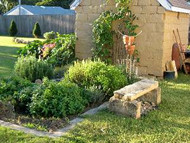How to Create a Raised Bed Herb Garden
A raised bed can provide the perfect environment for creating a herb garden. It can be positioned anywhere that suits you and can be maintained easily. A selection of plants can be mixed for a diverse range of foliage and aromatics.

Siting. If you intend to use the herbs for cooking it is best to place your raised bed conveniently close to the kitchen. It can be annoying to venture into the garden on a dark, wet, wintry evening to search for rosemary for your roast lamb. Choose a warm, sheltered spot without frost pockets bearing in mind that some Mediterranean herbs will appreciate full summer sunshine.
Soil. A general mixed compost with neutral pH is suitable for herb cultivation. Try to avoid high nitrogen feeds and improvers since these will promote fast growth at the expense of the delicate herb flavour. Herbs like a well drained soil so be sure to incorporate plenty of organic matter.
Layout. Plant the taller plants like rosemary in the centre of the bed and the shorter spreading herbs near the edges. This distributes shade fairly and allows you to reach across the bed for weeding and harvesting. When planting your herbs leave space between them to allow for growth and spread.

Crops to Grow. In most allotment gardens it is helpful to grow the vegetables that you like. This is mainly the case with herbs although many varieties can be planted just to provide a pleasant aromatic, ornamental display. Raised beds can give you the space to cultivate a broad selection of tasty culinary herbs while providing a splendid variegated display. Common examples are Basil, Rosemary, Parsley, Chives, Tarragon, Sage, Oregano and Thyme.
Care. Protect delicate, young herbs with cloches until they are established. Take time to weed around your plants and remove any dead leaves and branches. This can be achieved quite easily with the improved access of a raised bed. Feed your plants periodically with a general purpose fertilizer using the manufacturers instructions. Dead head flowers as they begin to fade, this will channel energy and growth into the foliage. Some herbs may only last one season although others will continue on year after year. Take the opportunity to increase your stock by taking cuttings or dividing the plant.

Harvesting. Most herbs will thrive from continued harvesting since foliage growth is stimulated as you take cuttings. Don’t cut back by more than a third of the plant and always snip just above the nearest leaf intersection. The cut herbs can used in the kitchen immediately or stored for later, frozen or dried. You can also capture the delicious flavour of your freshly picked herbs infused in oil for a tasty salad dressing.
